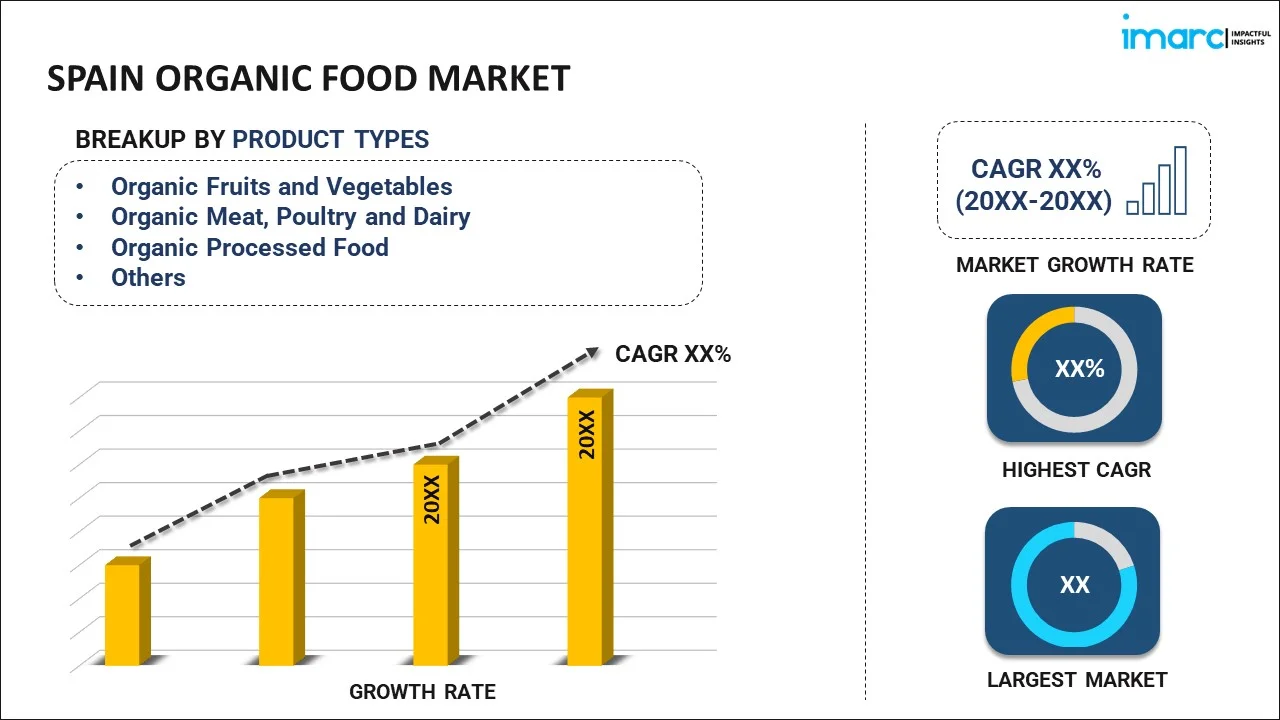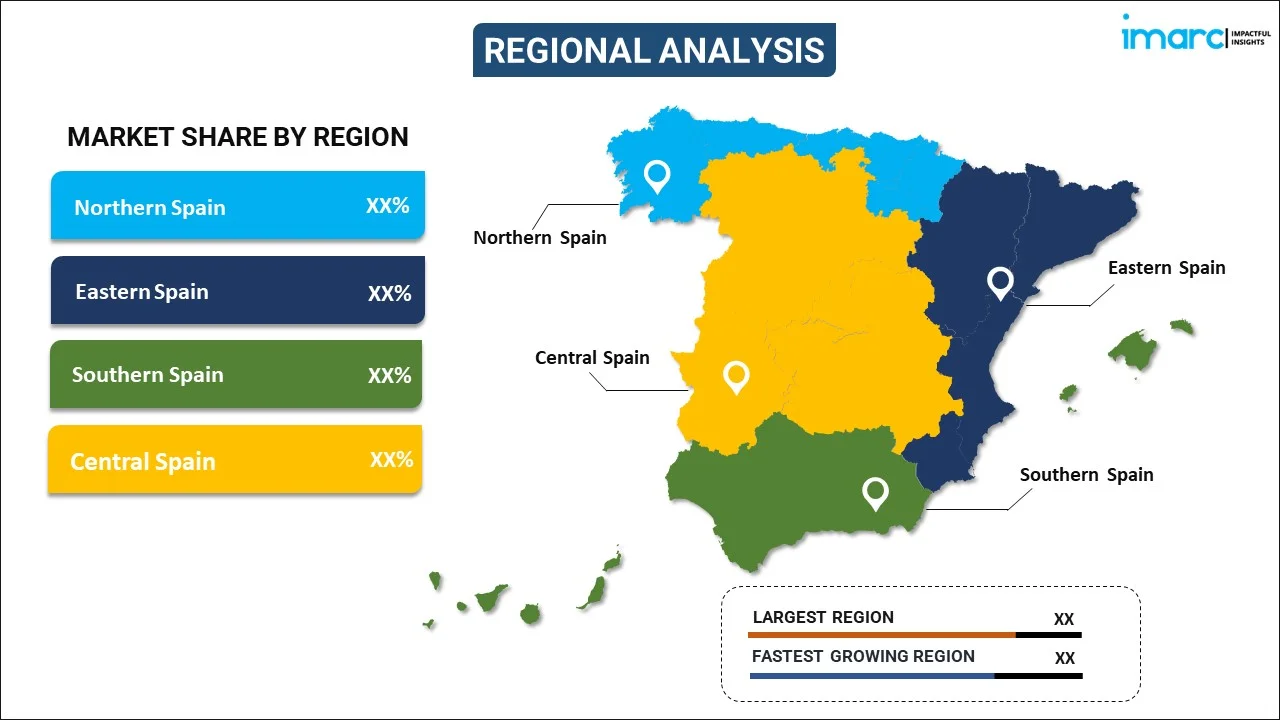
Spain Organic Food Market Report by Product Type (Organic Fruits and Vegetables, Organic Meat, Poultry and Dairy, Organic Processed Food, Organic Bread and Bakery, Organic Beverages, Organic Cereal and Food Grains, and Others), Distribution Channel (Supermarkets and Hypermarkets, Specialty Stores, Convenience Stores, Online Stores, and Others), Application (Bakery and Confectionery, Ready-to-eat Food Products, Breakfast Cereals, and Others), and Region 2025-2033
Spain Organic Food Market Overview:
The Spain organic food market size reached USD 3.8 Billion in 2024. Looking forward, IMARC Group expects the market to reach USD 12.5 Billion by 2033, exhibiting a growth rate (CAGR) of 14% during 2025-2033. Spain is one of the top global producers of organic food, with extensive farmland dedicated to it, holding the second-largest share of organic agricultural land in the EU and ranking fourth worldwide. Various factors are driving the market, including rising health consciousness, greater product availability through online and offline channels, and shifts in dietary habits linked to modern lifestyles.
|
Report Attribute
|
Key Statistics
|
|---|---|
|
Base Year
|
2024
|
|
Forecast Years
|
2025-2033
|
|
Historical Years
|
2019-2024
|
|
Market Size in 2024
|
USD 3.8 Billion |
|
Market Forecast in 2033
|
USD 12.5 Billion |
| Market Growth Rate 2025-2033 | 14% |
Spain Organic Food Market Trends:
Expansion of Retail Channels
The wide availability of organic food items via several distribution channels, such as supermarkets, hypermarkets, and convenience and online stores, is contributing to the market growth. People in Spain are preferring e-commerce platforms for purchasing organic food from Spain because they allow individuals to have organic products delivered directly to their homes, saving time and effort. These platforms offer a wider variety of organic products as compared to physical stores, providing more choices to consumers. In addition, consumers can easily compare prices across different platforms and read reviews from other buyers, helping them make informed decisions. E-commerce sites also offer discounts and promotional deals, making organic products more affordable to a wider consumer base. Apart from this, shopping online allows individuals to purchase products anytime and anywhere and eliminates the need to visit physical stores. They save time as individuals can quickly browse through products with just a few clicks on their smart devices and complete transactions without standing in queues. The rising need for hassle-free shopping experiences among people with busy lifestyles and hectic schedules is impelling the market growth. According to the ECDB, the e-commerce market in Spain predicted revenue of USD 33,536.1 Million by 2024.
Increasing Health Consciousness
The growing demand for organic items due to rising health consciousness among individuals is offering a positive market outlook. People are consuming healthier food products to maintain a healthy and active lifestyle. They are seeking food options that promote well-being and prevent lifestyle-related diseases. Health food products are free from synthetic pesticides and genetically modified organisms (GMOs) and perceived as healthier items. They offer a higher level of essential nutrients, such as vitamins, minerals, and antioxidants, as compared to conventionally grown food items. They prohibit the use of synthetic pesticides, herbicides, and fertilizers, which helps reduce the risk of exposure to harmful chemicals. They also have a better taste due to the natural farming methods and the absence of synthetic additives. As per the Organic Trade Association, the demand for organic products is anticipated to witness positive growth over the forecast period 2021–2026, with a CAGR of 4.0% during the period.
Expansion of Organic Land Use in Agriculture
Organic farming is steadily gaining ground in Spain’s agricultural sector. Farmers are transitioning conventional fields into certified organic land, driven by growing consumer interest and the push for sustainable practices. Areas like Andalusia and Castilla-La Mancha are leading this shift due to favorable conditions and local support. Vineyards, olive groves, and arable land are most commonly converted. Producers are adopting organic methods not just to meet demand but also to improve soil health and reduce chemical inputs. While yields may sometimes be lower than conventional methods, the long-term value proposition is stronger. This trend reflects a broad change in farming priorities, with more emphasis on ecological responsibility and market opportunities tied to clean-label and certified produce. This growth also aligns with the projected Spain organic food market size 2024, indicating strong economic incentives for farmers to expand organic acreage.
Public Policy and Financial Support Boosting Organic Growth
Spain’s organic food sector is benefiting from coordinated public support at both national and EU levels. Programs under the Common Agricultural Policy offer subsidies for farmers converting to organic methods, along with training and advisory services. The Farm to Fork strategy has helped align Spain’s goals with broader EU sustainability targets. In addition to financial backing, regional authorities offer support for certification, promotion, and research into better organic practices. These efforts lower the barrier to entry for new organic producers, particularly small and mid-sized farms. As a result, organic acreage is increasing, supply chains are maturing, and Spain’s profile in the organic food sector is becoming more competitive both domestically and internationally. Growth in segments like organic baby food is also drawing support due to increasing demand for clean nutrition in early childhood diets.
Steady Rise in Organic Food Exports
Spain is strengthening its role as a key exporter of organic food across Europe. Countries like Germany, France, the Netherlands, and Sweden are consistently increasing their demand for Spanish organic products, especially organic fruit, organic vegetables, olive oil, and wine. Producers are focusing on quality, certification, and traceability to meet strict buyer requirements. Spain’s climate, experience in agriculture, and cost advantage give it a competitive edge in supplying clean-label foods. Exporters are also investing in better logistics and international branding to expand their reach. This export momentum is shaping production decisions at the farm level, encouraging growers to scale up certified operations and maintain a steady pipeline of high-demand products. Meanwhile, niche categories like organic protein are emerging as areas of innovation, attracting health-conscious consumers across Europe.
Spain Organic Food Market Segmentation:
IMARC Group provides an analysis of the key trends in each segment of the market, along with forecasts at the country level for 2025-2033. Our report has categorized the market based on product type, distribution channel, and application.
Product Type Insights:

To get more information on this market, Request Sample
- Organic Fruits and Vegetables
- Organic Meat, Poultry and Dairy
- Organic Processed Food
- Organic Bread and Bakery
- Organic Beverages
- Organic Cereal and Food Grains
- Others
The report has provided a detailed breakup and analysis of the market based on the product type. This includes organic fruits and vegetables, organic meat, poultry and dairy, organic processed food, organic bread and bakery, organic beverages, organic cereal and food grains, and others.
Distribution Channel Insights:
- Supermarkets and Hypermarkets
- Specialty Stores
- Convenience Stores
- Online Stores
- Others
A detailed breakup and analysis of the market based on the distribution channel have also been provided in the report. This includes supermarkets and hypermarkets, specialty stores, convenience stores, online stores, and others.
Application Insights:
- Bakery and Confectionery
- Ready-to-eat Food Products
- Breakfast Cereals
- Others
The report has provided a detailed breakup and analysis of the market based on the application. This includes bakery and confectionery, ready-to-eat food products, breakfast cereals, and others.
Regional Insights:

- Northern Spain
- Eastern Spain
- Southern Spain
- Central Spain
The report has also provided a comprehensive analysis of all the major regional markets, which include Northern Spain, Eastern Spain, Southern Spain, and Central Spain.
Competitive Landscape:
The market research report has also provided a comprehensive analysis of the competitive landscape. Competitive analysis such as market structure, key player positioning, top winning strategies, competitive dashboard, and company evaluation quadrant has been covered in the report. Also, detailed profiles of all major companies have been provided.
Spain Organic Food Market News:
- In September 2024, Spain was honored with the Best Organic Food Retailer title at the 2024 EU Organic Awards, announced by the European Commission on September 23. Hosted by the EU agriculture commissioner, the awards recognize leaders in Europe’s organic sector. The event, in its third year, celebrated standout contributions from Italy, Spain, and Sweden in organic processing, retail, and food service.
- In March 2023, El Corte Inglés renovated its Preciados center in Madrid with a new supermarket concept, which incorporates a special space for prepared dishes, which it will implement in other centers in Spain and with the opening of a newly open restaurant concept 'Las Nubes Market'.
- In July 2022, CARREFOUR created 11 new French organic product lines covered by multipartite, multi-year contracts. Under this, the company will be able to sell high-quality French organic products while at the same time providing their producers with long-term visibility.
Spain Organic Food Market Report Coverage:
| Report Features | Details |
|---|---|
| Base Year of the Analysis | 2024 |
| Historical Period | 2019-2024 |
| Forecast Period | 2025-2033 |
| Units | Billion USD |
| Scope of the Report | Exploration of Historical Trends and Market Outlook, Industry Catalysts and Challenges, Segment-Wise Historical and Future Market Assessment:
|
| Product Types Covered | Organic Fruits and Vegetables, Organic Meat, Poultry and Dairy, Organic Processed Food, Organic Bread and Bakery, Organic Beverages, Organic Cereal and Food Grains, Others |
| Distribution Channels Covered | Supermarkets and Hypermarkets, Specialty Stores, Convenience Stores, Online Stores, Others |
| Applications Covered | Bakery and Confectionery, Ready-to-Eat Food Products, Breakfast Cereals, Others |
| Regions Covered | Northern Spain, Eastern Spain, Southern Spain, Central Spain |
| Customization Scope | 10% Free Customization |
| Post-Sale Analyst Support | 10-12 Weeks |
| Delivery Format | PDF and Excel through Email (We can also provide the editable version of the report in PPT/Word format on special request) |
Key Benefits for Stakeholders:
- IMARC’s industry report offers a comprehensive quantitative analysis of various market segments, historical and current market trends, market forecasts, and dynamics of the Spain organic food market from 2019-2033.
- The research report provides the latest information on the market drivers, challenges, and opportunities in the Spain organic food market.
- Porter's five forces analysis assist stakeholders in assessing the impact of new entrants, competitive rivalry, supplier power, buyer power, and the threat of substitution. It helps stakeholders to analyze the level of competition within the Spain organic food industry and its attractiveness.
- Competitive landscape allows stakeholders to understand their competitive environment and provides an insight into the current positions of key players in the market.
Key Questions Answered in This Report
The organic food market was valued at USD 3.8 Billion in 2024.
The Spain organic food market is projected to exhibit a CAGR of 14% during 2025-2033, reaching a value of USD 12.5 Billion by 2033.
The Spain organic food market is expanding due to heightened health awareness, increased demand for sustainable and local products, and government support for organic farming. Additionally, the growth of e-commerce platforms and the rise of plant-based diets are contributing factors.
Spain is one of the top producers of organic fruits and vegetables in Europe, with the second-largest area dedicated to organic agriculture in the European Union, following France.
Need more help?
- Speak to our experienced analysts for insights on the current market scenarios.
- Include additional segments and countries to customize the report as per your requirement.
- Gain an unparalleled competitive advantage in your domain by understanding how to utilize the report and positively impacting your operations and revenue.
- For further assistance, please connect with our analysts.
 Request Customization
Request Customization
 Speak to an Analyst
Speak to an Analyst
 Request Brochure
Request Brochure
 Inquire Before Buying
Inquire Before Buying




.webp)




.webp)












